Absolute indulgence has just made its way into the city straight from Pune and Bengaluru. We’re talking here about the arrival of exotic summer fruits like Jamun, Litchi, Mangoes and Fig. It is time to enjoy a glass full of fresh strawberries or other fruits with oodles of fresh cream. Served in a generous quantity, this makes for an ideal and indulgent dessert like no other on a hot day.
For most Mysureans, arrival of summer has always put a grin on their faces with the unsaid, delightful thought of enjoying summer fruits — relishing their juicy part and the sweet feel of after-taste lingering in their mouths for a long time. Be it the humble Jamun that comes from the outskirts of Mysuru or the strawberries that come from Pune or the Fig and the Mangoes that come from Bengaluru and even parts of Mysuru — it is worth the wait for summer and its special fruits.
RED STRAWBERRIES
For Mahadev from Rammanahalli village on the outskirts of Mysuru, summer is the time to make some money to sustain his family. He sells strawberries on the roadside in front of the Crawford Hall. “Summer season begins with the arrival of strawberries from Pune. We get it from the RMC Yard and sell them for small profits. My fellow villagers too are in this business and they are spread across the city including Kalidasa Road, Vishwamanava Double Road, near Saraswathipuram-Kuvempunagar junction, Yadavagiri near Akashavani, near Deputy Commissioner’s office and Vivekanandanagar,” he says.
“While mangoes, jackfruits, musk melons and watermelons are common in summer, exotic fruits like Jamun, Litchi, Fig and Rose Apples have a special place as they add colour and smooth juicy texture to salads and ice creams. These delicate and tasty fruits are also priced high,” he explains.
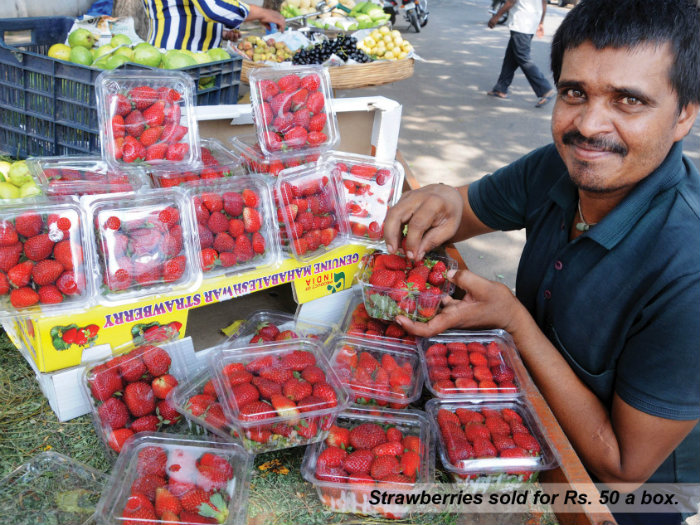
Mahadev sells a box of strawberries for Rs. 50 and each box contains over 15 to 20 fruits depending on the size. Ask him and he rattles out the many health benefits of strawberries. “These are little health gems that are delicious. They are also packed with heat-reducing nutrients and provide antioxidant benefits,” he explains.
Though hailing from Rammanahalli, Mahadev stays in K.G. Koppal as he has to travel all the way to the village after his routine sales. “I manage to sell five to six big boxes of the fruit after dividing and repackaging them in small boxes. The strawberry season will get over in a couple of days and the next fruits to arrive will be Jamun, Mangoes and Litchis,” he says.
THE HUMBLE JAMUN
Jamun (Nerale Hannu) fruit or the black plum with scientific name Syzygium Cumini is also known as jambul, jambolan, jamblang or jamun. In Mysuru, the fruit is grown in abundance at Rammanahalli, Hanchya and surrounding villages.
Jamun trees are known for its thick shade and the fruits are small and sweet and bluish in colour. As one eats the fruit, tongues turn blue and Jamun berries leave a fruity-dry feeling in the mouth. Though the small variety of jamun is available in abundance in villages, people have become used to eating the large hybrid variety that has a lot of flesh and bigger seeds when compared to the smaller ones.
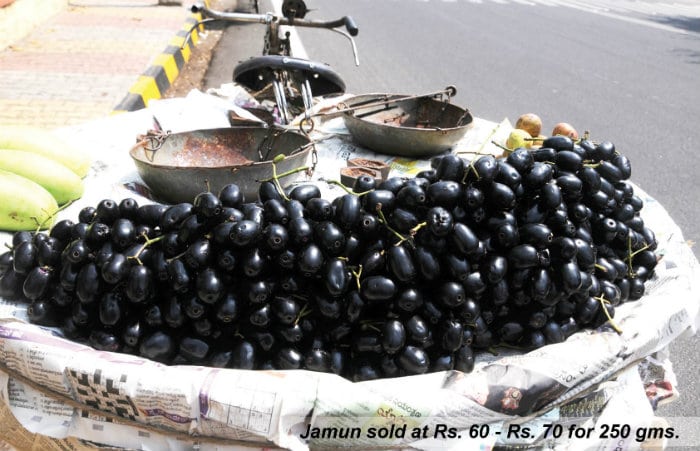
Every year, Jamun sellers can be seen all over the city. Some vendors have been coming for many years and some since their childhood. Sellers come from the villages on bicycles with the fruits and sell them directly to the buyers. Enterprising sellers sell the fruits for Rs. 60 to Rs. 70 per quarter kg and make marginal profits.
Jamun fruit is good for a diabetes patient as it has many anti-diabetic features. It helps convert starch into energy and keeps blood sugar levels in check. It is low on glycemic index and reduces diabetes symptoms like frequent urination and thirst. It also increases haemoglobin content and helps in keeping skin healthy.
RIPE FIG, LUSCIOUS LITCHIS
Another exotic fruit that has made its appearance in the city is the Fig with its tiny seeds, rough surface and sweet taste. Though figs were not sold in abundance last year, this year it has made a big entry.
While most of us are used to eating processed, dried and juicy fig that comes as part of dry fruit assortment, it is a unique experience to taste the fruit in its natural format.
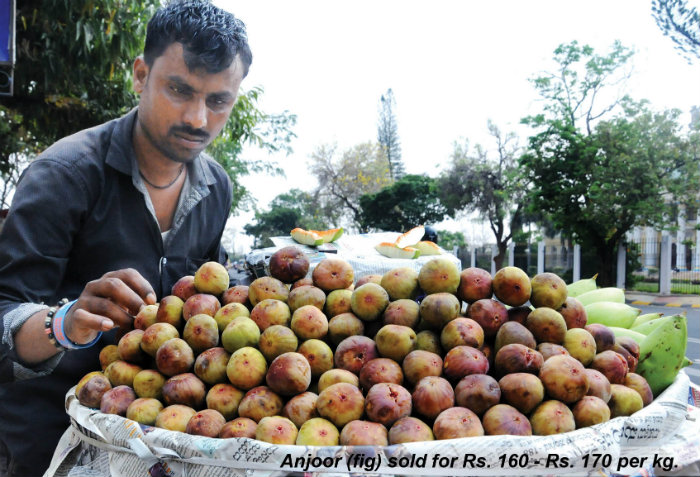
Shankar sells fig (anjoor) in front of Crawford Hall. “Anjoor is a bit expensive and I sell them for Rs. 160 to Rs. 170 per kg. Though many people do not like the taste and texture of fresh Anjoor, die-hard fans of this fruit purchase them and I manage to sell over 20 kgs per day,” he said.
Figs are high in fibre and a good source of several essential minerals, including magnesium, manganese, calcium (which promotes bone density), copper and potassium (which helps lower blood pressure), as well as vitamins. Figs are a good source of potassium, a mineral that helps to control BP.
The most loved and the most expensive exotic fruit of summer is the litchi or lychee. It is the member of the soapberry family, Sapindaceae, and is a tropical fruit tree native to the Guangdong and Fujian provinces of China. The fruit is a good source of several vitamins, minerals and healthy antioxidants. Besides being sweet and nutritious, these berries bring cooling effect on the body to beat the summer heat.
Litchi has a very short shelf life though it offers numerous benefits to skin, hair and health. A kilogram of litchi is usually sold in Mysuru for Rs. 380 to Rs. 400. However, you will have to wait for some more time to savour luscious litchis.
MANGOES
Summer is the time when one bites into fleshy, juicy and sweet mangoes with yellow juice dripping from the sides of the mouth and flowing all over the hand.
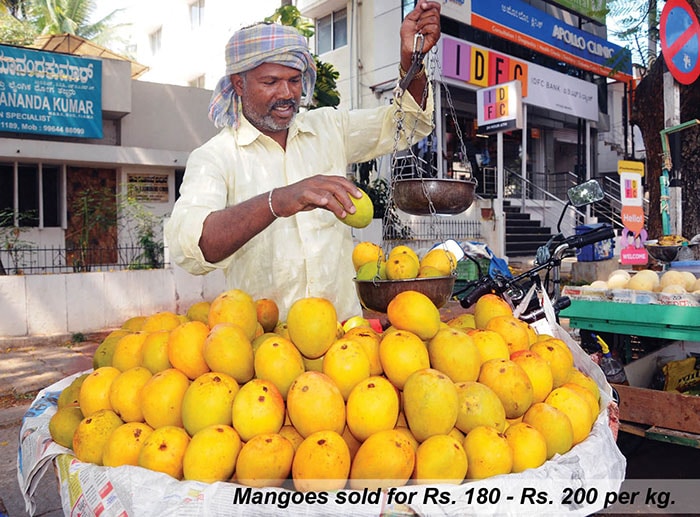
While more varieties are expected to arrive in city in the coming days, the Badami variety has already arrived. Of course, since it is only the beginning of the mango season, the fruits are expensive. Revanna from Rammanahalli, who sells these mangoes near Crawford Hall, says that he buys the fruit for Rs. 180 per kg in a mango Mandi and sells it for Rs. 200 here.
“Yes it is expensive and while buying too, I am very careful not to buy in bulk as the customers are choosy. Before buying they ask me a lot of questions like if the fruits are ripened naturally or if chemicals are used. However, I manage to sell at least 50 kgs per day,” he says.
Thotapuri mangoes

Not just ripe mango, raw and semi-ripe Thotapuri mangoes too have arrived in the city and are a hit among college students and youth who cut and eat it with salt and chilli powder. Enterprising vendors near Crawford Hall also carry a pack of salt and chilli powder and serve the cut Thotapuri mangoes to discerning customers.



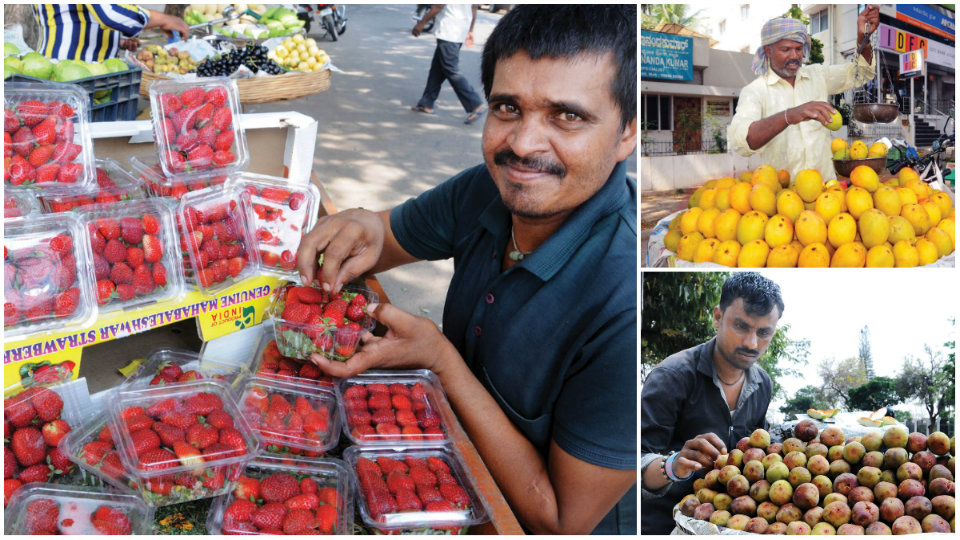




Recent Comments